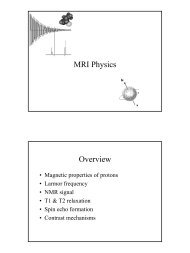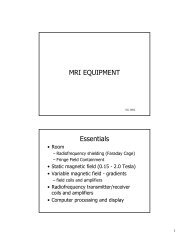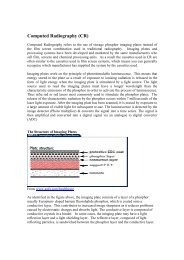Dosimetry introduction
Dosimetry introduction
Dosimetry introduction
Create successful ePaper yourself
Turn your PDF publications into a flip-book with our unique Google optimized e-Paper software.
now behave as if unbound & undergo billiard-ball type collisions with incomingphotons. The original photon goes off at an angle, & with reduced energy.The recoil electron also goes off at an angle with the remainder of the photonenergy. The electron may travel only in the forward direction; the photon maytravel in any direction, including backwards.The extent of CS is proportional to electron density in the absorber, hencedense materials (such as Barium) cause more CS. This will explain the lossof radiographic contrast at high kVp. Tissues of similar atomic number butdifferent density, ie water & air are better visualised at higher kilovoltage. Thisis the basic principle of the high kVp technique used in clinical examinations.CS radiation distributes the dose deeper in the body than PEA, sparing theskin, but even affecting organs outside the original irradiated area.IncomingPhotonElectronNow ejectedOrbitingElectronPhotoelectric absorptionRecoilElectronIncidentPhotonPoint ofInteractionScatteredPhotonCompton Scatter5
















